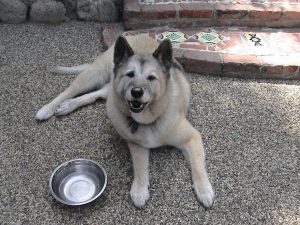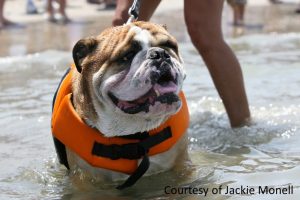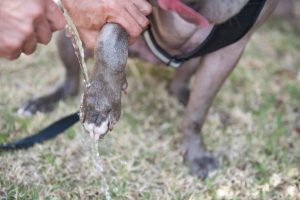 It only takes a short period of time for a dog or cat left in a car to get into a deadly situation — 70°F is actually considered too hot in a car! Pets don’t sweat to regulate their body temperature (normally 100.4°F – 102.5°F). Instead, they release heat through their tongue, nose and foot pads. Dogs pant to exchange cooler outside air with the warm humid air in their lungs while cats don’t usually pant until they are overwhelmed by the heat. If the outside air isn’t cooler than the pet’s body temperature, the animal can quickly become overheated. Extremely overheated pets may actually leave behind paw prints as they sweat out their pads!
It only takes a short period of time for a dog or cat left in a car to get into a deadly situation — 70°F is actually considered too hot in a car! Pets don’t sweat to regulate their body temperature (normally 100.4°F – 102.5°F). Instead, they release heat through their tongue, nose and foot pads. Dogs pant to exchange cooler outside air with the warm humid air in their lungs while cats don’t usually pant until they are overwhelmed by the heat. If the outside air isn’t cooler than the pet’s body temperature, the animal can quickly become overheated. Extremely overheated pets may actually leave behind paw prints as they sweat out their pads!
Hyperthermia is an elevation in body temperature. Generally anything above 103°F (39°C) is considered abnormal.
Heat Stroke is a form a hyperthermia that occurs when the heat-dissipating mechanisms in a pet’s body cannot compensate for external temperatures. Without prompt attention, heat stroke can result in multiple organ failure including brain damage, kidney failure, cardiac arrest and death. Older and overweight pets as well as short-nosed breeds are at the greatest risk.
Sometimes indicating slightly lower degrees of increased body temperature, Heat Distress and Heat Exhaustion are often used interchangeably to denote Heat Stroke.
 What’s a Pet Parent to Do?
What’s a Pet Parent to Do?
Walk dogs during the cooler parts of the day and stick to shady areas and grass. Even beach sand can burn paws and make a canine body too hot! Remember…if it’s too hot for you to walk barefoot on it, it’s too hot for four paws!
Always make sure pets have a supply of cool fresh water. If that outdoor water bowl has become a bird bath, is empty or is sitting in the blazing sun, it is not a good source of hydration for Fido!
Make sure dogs in fenced yards always have shade to retreat to. Notice the situation at different times of the day and year to make sure the shade cast by backyard trees isn’t only on the other side of the fence in the neighbor’s yard leaving a dog to fend for himself in the hot sun.
NEVER leave an animal in a parked car for even a moment. If he can’t get out with you at every stop, he is better off home in a temperate environment.
|
AIR TEMPERATURE |
TEMPERATURE
INSIDE CAR |
SURFACE
TEMPERATURE
|
|
75°F |
118°F |
125°F |
| 85°F | 140°F |
135°F |
Know your groomer! Blow drying animals in a well-ventilated area is important to health, while cage dryers (big boxes shampooed animals are place in that allows forced air to dry them) must be carefully monitored. On a side note, dogs prone to seizures may suffer convulsions caused by the frequency of dryers, so always let groomers know if this might be a potential problem.
Pay particular attention to senior, over-weight and brachycephalic (flat-faced) dogs who have more difficulty breathing even at comfortable temperatures.
Be on the Lookout for:
Heavy panting or gasping
Vomiting (if not yet dehydrated) and/or foam around the mouth
Weak or high pulse (If something is not normal, it is abnormal!)
Inability to drink
Bright red or suddenly bluish gums
Loss of consciousness
Sweating from the paws!
Heat stroke is a life-threatening emergency that requires veterinary treatment. The goal is to remove the animal from the source of the heat, prevent internal body temperature from continuing to rise and transporting to a Veterinarian as quickly as possible. Although generally brought on by external heat, some poisonous compounds, such as strychnine and slug and snail bait, can lead to seizures, which can cause an abnormal increase in body temperature.
Your Pet First Aid Kit and Then Some
- Water from a garden hose, tub, wading pool, sink, even a spray bottle but make sure it’s not hot from being in the sun. In other words, let that initial stream out of the hose run away from the pet until it is a comfortable temperature.
- Thermometer and lubricating gel
- Karo Syrup® or Honey

To the Rescue
- Move the animal to a cooler environment. Indoors is best with a cool fan blowing on the pet but even a shady sidewalk or grassy area can help.
- Wet dog or cat with lukewarm/room temperature water (ice causes blood vessels to restrict flow and can lead to Shock) “from the paws up” getting the paws, pits, groin and belly skin amply wet. Water often skids off fur on most breeds and takes longer to reach the skin when applied to the back. If you place a pet in a tub or pool, do not let the water rise higher than the belly. Immersing him to the neck will cause his temperature to drop too much too fast resulting in hypothermia. Rubbing alcohol or witch hazel wiped onto the inner flaps of the ears and pads of the feet also produces a cooling effect. Do not however douse an animal with an entire bottle of rubbing alcohol which could cause a sudden change in body temperature and result in shock. Also avoid getting alcohol in any cuts or scrapes as both sting. Placing a cool pack or bag of frozen peas on the pet’s neck and groin can prove helpful in cooling him off as the cooled blood flowing to major arteries effectively cools the rest of the body. Remove pack every few minutes to make sure you don’t cause frost bite or reduce temperature drastically. If an animal is suffering from any heat-related illness, do not force him to drink as fluid could be aspirated into the lungs. Instead, dribble water from an eye dropper or spray bottle to keep pet hydrated. At the Veterinarian’s office, fluids will likely be administered subcutaneously or intravenously.
- Check pet’s temperature and if it is 104°F or higher, get to the Veterinarian immediately! Wrap animal in wet sheet or towel, turn on car air conditioning and drive quickly but safely.
- If pet goes unconscious, rub a little honey or Karo Syrup® on his gums to increase blood sugar level, and be prepared to administer CPCR.
If the pet cools too quickly and temperature drops to 100°F, cover him with a blanket and place a 2-liter bottle filled with warm (not hot) water next to him as you transport him to the Animal ER.

BUNNIES!
Domesticated rabbits are truly indoor pets. They are in danger once temperatures reach 80°F. If a bunny you care for lives in an outdoor hutch, she must be well-protected from the elements and have a mister system, fan or other way to keep the environment below that magic number or she may suffer hyperthermia.
Rabbits only have sweat glands in their lips. They use their ears to cool blood vessels so may rotate or flap them when too hot.
Rabbits may actually stop drinking water when they need it most and may salivate excessively when too hot.
Action Steps are few:
- Mist with cool water.
- Transport to rabbit appropriate veterinarian at once.







